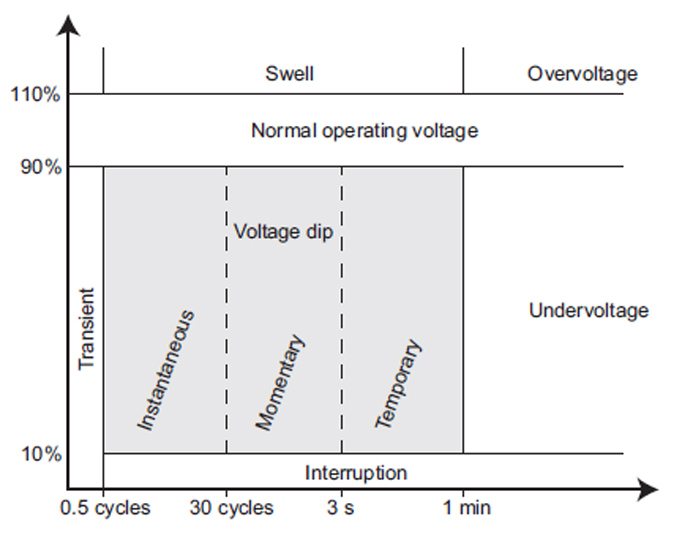What is a voltage dip?
A voltage dip is a short, temporary drop in the voltage magnitude in the distribution or customer’s electrical system. It may be caused by various faults in the transmission and distribution networks, faults in the connected equipment or high inrush and switching currents in the customer’s installation.
A voltage dip also referred to as voltage sag, can affect the operation of equipment such as the electronics and other sensitive equipment connected to the grid. The effect varies from equipment to another and depends on the severity of the dip, its duration, magnitude and ability of the equipment to withstand the voltage reduction.
A dip is said to occur when a drop to between 10 and 90 percent of the normal value occurs during 0.5 cycles and lasting for up to 1 minute. Dips are classified according to their magnitude and duration and may be one of the following:
- Instantaneous last between 0.5 and 30 cycles which translates to between 10 and 600 ms in a 50Hz supply system
- Momentary 30 cycles and 3 seconds
- Temporary 3 seconds to 1 minute
Most dips only last between 0.5 cycles to 1 second; longer durations may be a sign of severe faults in the system and can lead to bigger problems.
In addition to the magnitude and duration, the other attributes used in defining dips are the phase jump and point on wave.
Fig1: Voltage dips according to IEEE Std. 1159-1995 (2) – Image Source
Causes of Voltage dips
A dip affects the power quality of a system and may arise from a huge current being drawn in another part of the system due an overload, a short circuit, energizing of a transformer, starting machine or any other temporary high current intake system.
A voltage dip is does not interrupt the power supply and most of them lasts for less than one tenth of a second. The dips are either from the distribution networks or from in-house equipment. The disturbances in distribution lines caused by weather conditions, lightening, vegetation, excavation, third party interference damages.
The in-house causes are due to the switching on of high-current equipment such as air conditioners, microwave, furnace fans, hair driers, motors etc.
Reducing the Impact of voltage dip on Electronic equipment
Some of these causes are unavoidable, the dip may not affect the power supply and equipment significantly; but the consumers may experience momentary flickering or dimming of the lights.
However, some sensitive equipment may trigger their protection systems leading to tripping. An uninterruptible power supply or voltage stabilizers are sometimes used to maintain a constant voltage over a wide range of input voltages.
The dip affects computers and other sensitive electronics equipment in various ways based on the dip characteristic. The response of electronic equipment whether using regulated or unregulated power supplies can be improved to withstand voltage dips by the use of a large hold-up capacitor.
